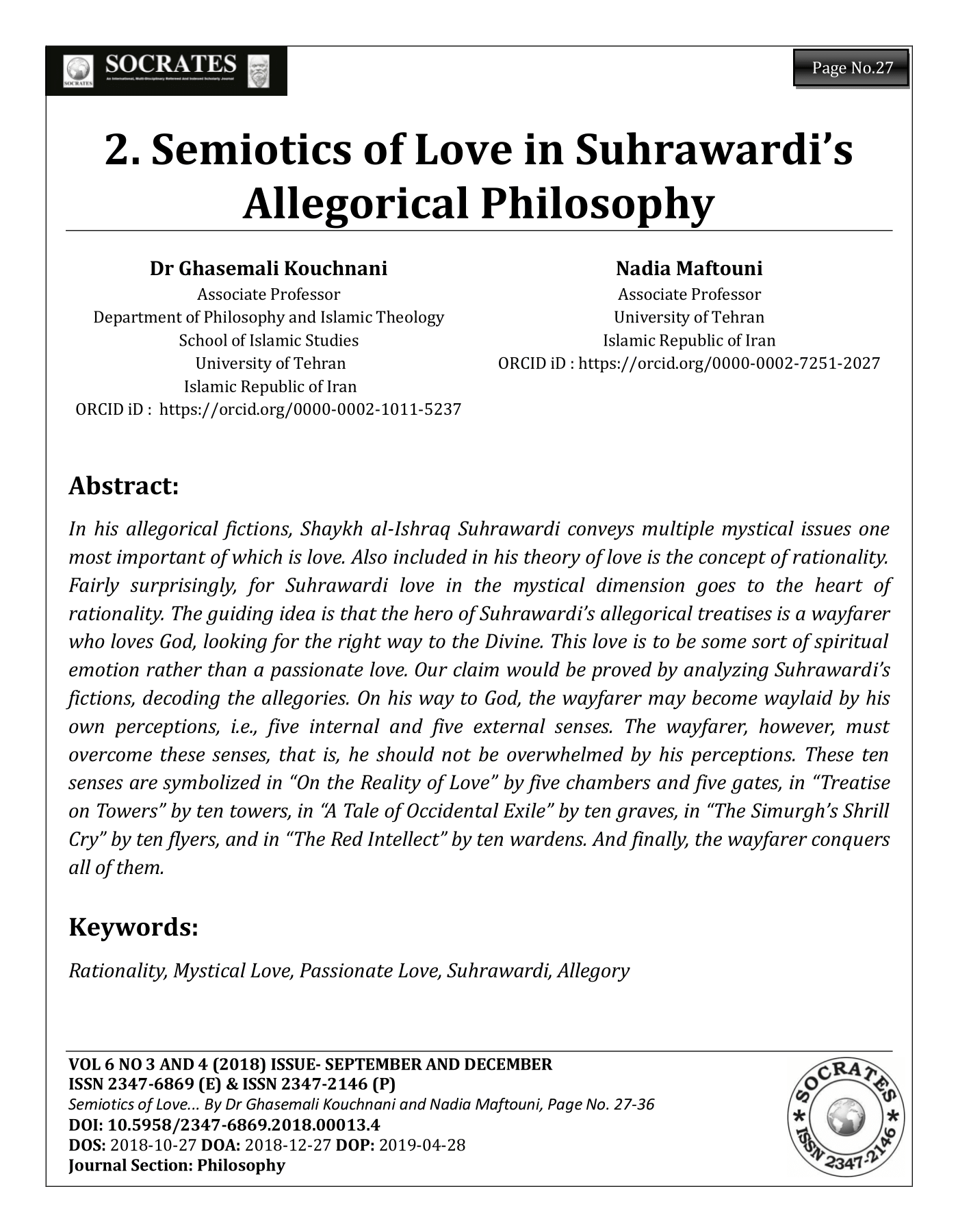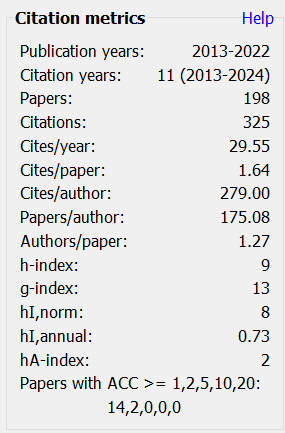Semiotics of Love in Suhrawardis Allegorical Philosophy
DOI:
https://doi.org/10.5958/2347-6869.2018.00013.4Keywords:
Rationality, Mystical Love, Passionate Love, Suhrawardi, AllegoryAbstract
In his allegorical fictions, Shaykh al-Ishraq Suhrawardi conveys multiple mystical issues one most important of which is love. Also included in his theory of love is the concept of rationality. Fairly surprisingly, for Suhrawardi love in the mystical dimension goes to the heart of rationality. The guiding idea is that the hero of Suhrawardi’s allegorical treatises is a wayfarer who loves God, looking for the right way to the Divine. This love is to be some sort of spiritual emotion rather than a passionate love. Our claim would be proved by analyzing Suhrawardi’s fictions, decoding the allegories. On his way to God, the wayfarer may become waylaid by his own perceptions, i.e., five internal and five external senses. The wayfarer, however, must overcome these senses, that is, he should not be overwhelmed by his perceptions. These ten senses are symbolized in “On the Reality of Love” by five chambers and five gates, in “Treatise on Towers” by ten towers, in “A Tale of Occidental Exile” by ten graves, in “The Simurgh’s Shrill Cry” by ten flyers, and in “The Red Intellect” by ten wardens. And finally, the wayfarer conquers all of them.
DOI: 10.5958/2347-6869.2018.00013.4
Downloads
Metrics
References
Algazel, A. H. (1343H). Faraed al-Layali, n.p., Qahirah.
Furness, H. H. (1880). A New Variorum Edition of Shakespeare: King Lear.
Homerin, T. E. (2011). Passion Before Me, My Fate Behind: Ibn Al-Farid and the Poetry of Recollection. SUNY Press.
Ibn Sina, H. (1990). “The Treatise of the Birds”, Al-Rasael, Edited by Mohsen Bidarfar, Bidar Publication, Qum, pp. 401-414.
Lewis, C. S. (1990). "Sense", Studies in Words (2nd ed.), Cambridge University Press, Cambridge.
Maftouni, N. (2015) Negarehay-e- Ishra?q?, Vaya Publication, Tehran
Marcotte, R. (2012). “Suhrawardi”, Stanford Encyclopedia of Philosophy, Stanford.
Merriam-Webster, Inc (Ed.). (1991). The Merriam-Webster new book of word histories. Merriam-Webster.
Reichert, M. (2014). Between Courtly Literature and Al-Andaluz: Oriental Symbolism and Influences in the Romances of Chretien de Troyes. Routledge.
Simpson, J.A. and E.S.C. Weiner (eds.) (1989). Oxford English Dictionary, 2nd ed., Clarendon Press, Oxford.
Suhrawardi, S. (1999). The Philosophical Allegories and Mystical Treatises, Edited and Translated by W. M. Thackston, Mazda Publishers, Costa Mesa.
Suhrawardi, S. (2002). Majmu?’a-i Musannafa?t-i Shaykh-i Ishra?q, vols. 2-3, Tehran: Paju?hishga?h-i ‘Ulu?m-i Insa?ni? Wa Muta?li’a?t-i Farhangi? Press.
Walbridge, J. (2011). The Devotional and Occult Works of Suhraward? the Illuminationist.

Downloads
Published
How to Cite
Issue
Section
Categories
License
Copyright (c) 2019 Ghasemali Kouchnani, Nadia Maftouni

This work is licensed under a Creative Commons Attribution-NonCommercial 4.0 International License.
Revised Copyright/CC license that applies to all the articles published after 05-02-2017
Attribution-NonCommercial 4.0 International (CC BY-NC 4.0)

Copyright/CC license that applies to all the articles published before 05-02-2017
Attribution-Non Commercial-No Derivatives 4.0 International (CC BY-NC-ND 4.0)

Author(s) will retain all the right except commercial and re-publishing rights. In the case of re-publishing, they will have to obtain written permission from the journal. Additional licensing agreements (Creative Commons licenses) grants rights to readers to copy, distribute, display and perform the work as long as you give the original author(s) credit, they can not use the works for commercial purposes and are not allowed to alter, transform, or build upon the work. For any reuse or distribution, readers and users must make clear to others the license terms of this work. Any of these conditions can be waived if you get permission from the copyright holders. Nothing in this license impairs or restricts the authors’ rights. To view a copy of this license, visit http://creativecommons.org/licenses/by-nc-nd/4.0/ or send a letter to Creative Commons, 171 Second Street, Suite 300, San Francisco, California, 94105, USA.
Research Papers published in SOCRATES are licensed under an Attribution-NonCommercial-NoDerivatives 4.0 International (CC BY-NC-ND 4.0)
















